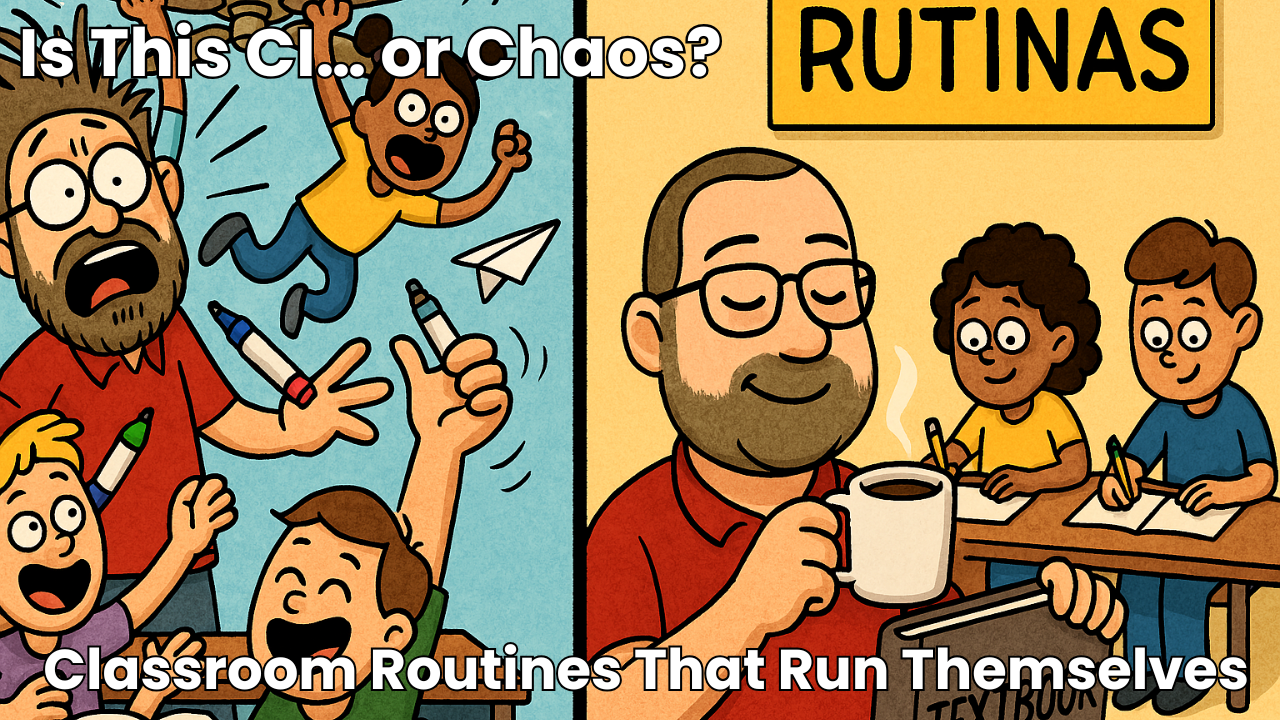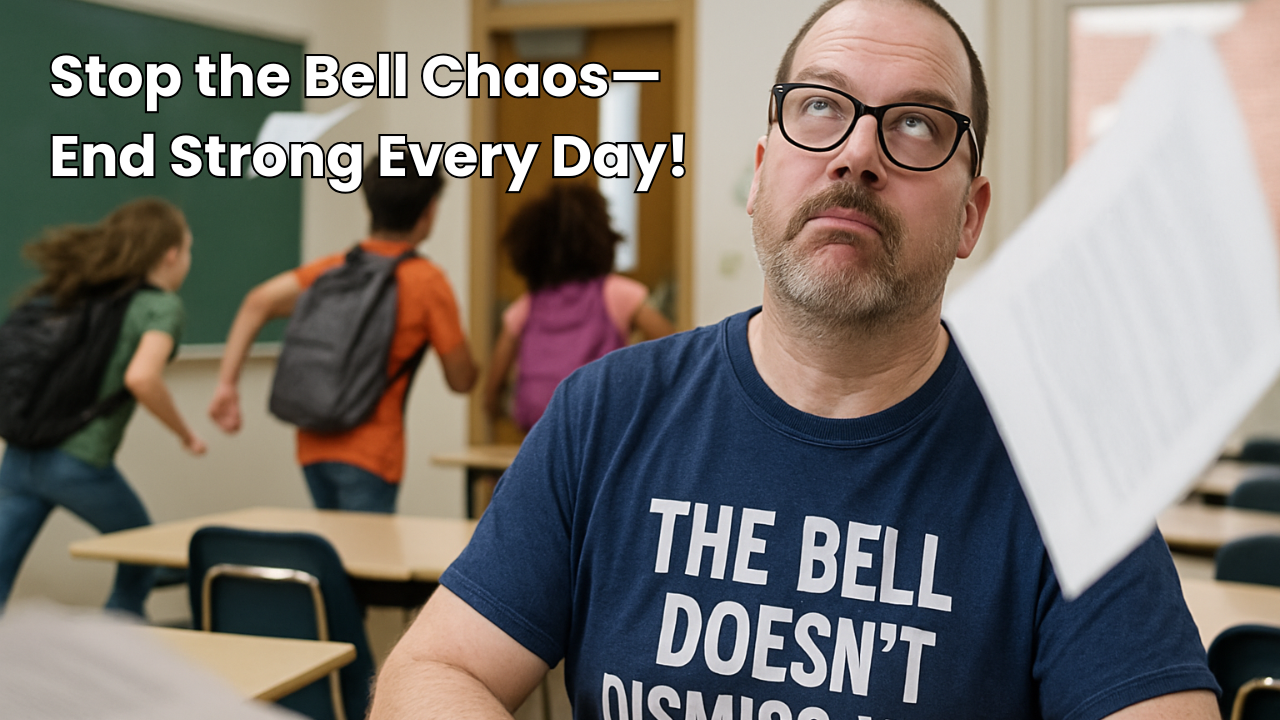
Build independence and reduce behavior issues with consistent structure (and zero need for Jedi mind tricks)
Introduction: When Your Class Feels Like a Reality Show… and You’re the Host, Cameraman, and Therapist
Imagine this: You enter your classroom, and without saying a single word, your students begin working. There’s no screaming. No chaos. No one is tap-dancing on the desks. It’s like a beautifully choreographed flash mob of comprehension and calm.
Now… snap back to reality. Because for many of us, the real scene looks more like this:
- A pencil fight breaks out before you take attendance.
- Someone yells “Profe, I can’t find my Chromebook and I think my shoelace is haunted!”
- You’re trying to start class while internally asking, “Is it too late to become a barista in Bali?”
Friend, I see you. I am you. But here’s the thing: You don’t need to rule with an iron fist or chant “CI is love, CI is life” in a corner. What you need—what we all need—are routines. Glorious, predictable, plug-and-play routines that practically teach your class for you.
And no, this doesn’t mean turning your room into a military bootcamp. It means creating rituals that train students to know what’s coming, so they don’t have to use their brain cells on logistics—they can use them on language. This article will give you routines so smooth, your students might start running the class themselves—and you might finally be able to sit down.
1. The Magical, Mystical Power of Bell Ringers (a.k.a. "I’m Not Ready But Class Already Started")
Let’s begin with the first sacred moment of every class: the 0.5 seconds between the bell ringing and all heck breaking loose.
Your bell ringer isn’t just a time-filler. It’s your first act of sorcery. It sets the tone, establishes expectations, and—if done right—lets you take attendance without screaming over interpretive desk dances.
Want routines that run themselves? Start here:
Bell Ringer Option #1: “What the Heck is Happening in This Picture?”
Project a ridiculous image. Bonus points if it includes talking animals, flying tacos, or llamas in business attire. Ask students:
“¿Qué está pasando?”
Have them write one sentence, or turn to a partner and whisper their guesses. Suddenly, they're in Spanish mode without you lifting a finger.
Bell Ringer Option #2: “Meme of the Day”
Same idea, but with memes. Yes, Gen Z is fluent in memes. Ask students to interpret it in the TL. “This penguin is clearly saying, ‘No me gusta la clase de matemáticas.’” Is it accurate? Who cares. They’re thinking in Spanish and you haven’t even said “Hola.”
Bell Ringer Option #3: “CI DJ of the Day”
Assign a student to play the same welcome song every day. It’s a cue for them to settle and for you to sip your coffee like the CI boss you are. You can rotate songs weekly, but the ritual stays the same.
Your students will come in, hear the music, see the prompt, and know what to do. You could be lying under your desk with a cold compress and they’d still be writing about a llama in a jetpack. That’s routine magic.
2. Instructions That Could Be Delivered By a Squirrel Puppet (and Still Work)
We’ve all been there: You give directions. You say them clearly. Maybe you write them down. Maybe you say them again. And then:
- “Wait, what are we doing?”
- “Are we supposed to turn this in?”
- “Can I go to the bathroom even though I’m holding a glue stick and crying?”
No more. With a rock-solid instruction routine, your directions don’t just exist—they live rent-free in their heads.
Here’s how you do it:
Step 1: Say It the Same Way. Every. Single. Time.
Pick a pattern. “Primero, después, al final.” Or “Toma tu lápiz. Escribe.” Then beat that rhythm into the ground like it owes you rent. Students love predictability. They may act like chaos goblins, but their brains crave structure like it’s TikTok at midnight.
Step 2: Gesture Like You’re in a Telenovela
Use the same gestures every time. Want them to write? Mime furious scribbling. Want them to listen? Cup your ear. Want them to stop talking? Freeze and stare with the intensity of a soap opera villain. They’ll get the message.
Step 3: Call and Response = Instant Engagement
Try “¿Listos?” / “¡Listos!” Or “¿Qué hacemos?” / “¡Escuchamos!” Train it like a fire drill. Students will respond automatically—and probably feel a little smug about it.
When you deliver directions with consistent structure and exaggerated flair, you’ll spend less time repeating yourself and more time doing actual CI… or sipping the coffee you forgot in the microwave again.
3. Transitions So Smooth They Make Butter Jealous
Okay, real talk. Transitions are where routines either shine or implode like a badly made flan. Done well, they create flow. Done badly, they make you question your career choices.
Luckily, there’s hope—and possibly a soundtrack.
Strategy #1: The CI Sound Cue
Pick a 3-second clip: a dramatic violin sting, a SpongeBob “My leg!” yell, or a jingle that screams “New Activity Alert.” Students hear it, and BAM—they know it’s time to shift gears.
Strategy #2: Transition Words With Flair
Teach the phrase “¡Cambio!” and throw in a ridiculous gesture. Maybe a jazz hand twirl. Or a dramatic “teacher-spin.” Yes, you’ll look silly. That’s the point. They’ll remember it, copy it, and suddenly your transitions feel like a Broadway number.
Strategy #3: 1-Minute Movement Challenge
Need to move from story time to write-and-discuss? Set a timer and say: “Find a new seat partner wearing the same number of shoelaces as you.” Now they’re laughing and moving and not stabbing each other with dry erase markers. Win-win.
Smooth transitions reduce downtime, redirect energy, and keep students in “input mode” instead of “feral middle schooler mode.”
4. Student Jobs That Make You Feel Like You Hired a Mini CI Intern Army
You: “I can’t do everything myself.”
Also you: Does everything yourself while balancing a projector remote and a broken pencil sharpener.
Friend. You need student jobs. Not just because they help you. Because they train your kids to take ownership of the class—and that means fewer behavior issues and more independence.
Job #1: El DJ de Clase
This student starts your welcome music or sound cue. Bonus: They get to wear sunglasses. Because they’re that cool.
Job #2: La Voz del Día
Each day, one student delivers a phrase or question in the TL. They lead the chant. They become the mini-Profe. Their ego will grow 300%. Your engagement will too.
Job #3: The CI Hype Person
This one’s gold. Their job? Cheer. Clap. Shout “¡Sí se puede!” when someone gets a tricky phrase. This job spreads hype like glitter in a craft store.
Assign jobs weekly. Let students apply or create campaign posters. The more ownership they feel, the more your class becomes our class. And yes, that means less management and more acquisition.
5. Closure Routines That Wrap It All Up Like a Netflix Season Finale
The last 5 minutes of class should feel like a well-directed movie ending—not like everyone’s scrambling for their backpacks and forgetting your name.
Routine #1: Exit Ticket with a Twist
Ask “What was today’s weirdest word?” or “What’s something you could tell your abuela about this class?” Keep it funny, keep it reflective, and keep it in Spanish.
Routine #2: Two Words and a Face
Each student says two new words they learned and makes a facial expression that shows how they feel about the class. You will get drama. You will get weird faces. You will get joy.
Routine #3: The CI Mic Drop
End with a phrase-of-the-day chant. Or a dramatic “¡Nos vemos!” and a superhero pose. It sounds silly because it is. But it sticks. Your class gets a consistent, positive ending—and you don’t have to shout, “THE BELL DOESN’T DISMISS YOU.”
Conclusion: You Can Have Calm AND Comprehension
Look. You didn’t sign up for teaching to become a full-time manager of paperclip theft and hallway drama. You’re here to help kids acquire language. And the way to do that? Structure. Routines. Predictability with a touch of flair.
When your classroom routines are tight, your input flows. Your students thrive. You thrive. And suddenly, your CI class is less “barely surviving” and more “thriving while wearing a taco hat.”
Need help figuring out where to start? Take the CI Proficiency Quiz and get clarity on your next step—plus bragging rights.
And if classroom chaos is still a frequent guest star in your CI sitcom, grab a front-row seat in my Dynamic Discipline Course. It’s funny, effective, and it doesn’t require you to be a dragon with a clipboard.
Now go forth and routine like a boss.
📝 Key Takeaways
- Bell ringers should be weird, funny, and in Spanish—they set the tone before class even starts.
- Consistent directions save time, energy, and your voice. Bonus points for over-the-top gestures.
- Transitions need flair. Use sound, movement, and repetition to create seamless shifts.
- Student jobs build ownership, reduce disruptions, and give you a break. Let them help!
- Closure routines give students a sense of completion—and you a sense of control.



